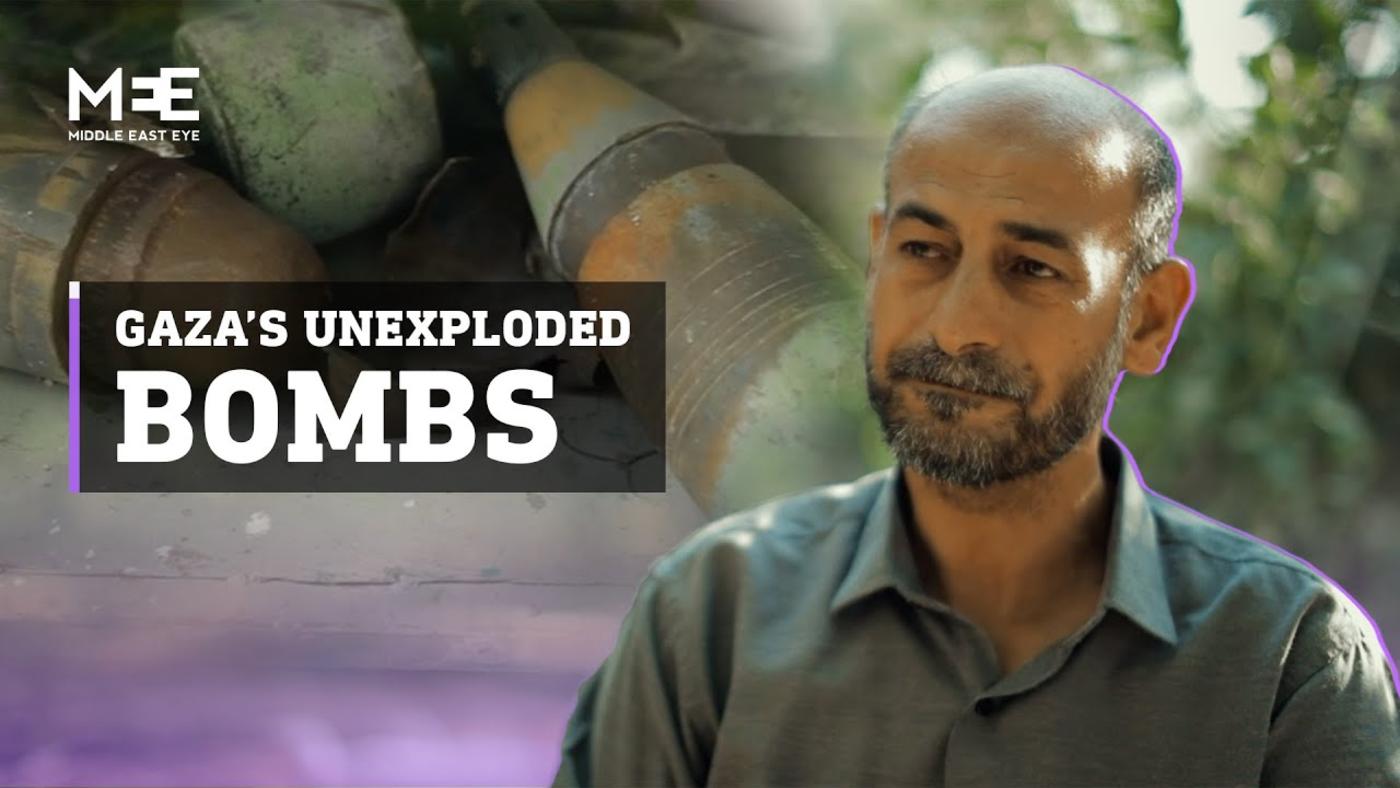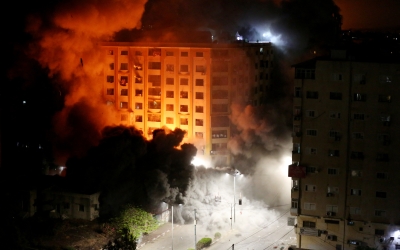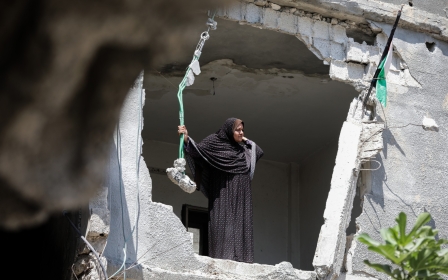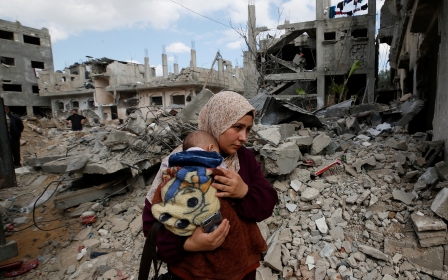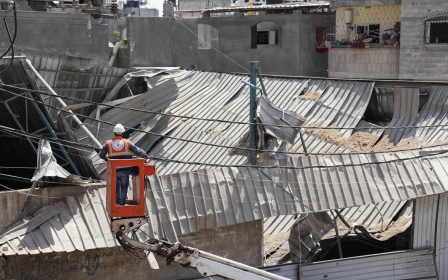'The war is not over': The Gaza Strip's unexploded bombs
Gaza City, besieged Gaza Strip/London — Weeks after the end of Israel's most recent bombardment of the Gaza Strip, on 9 June, 16-year-old Ahmed al-Dahdouh went to fetch his younger brother, Obaida, from his uncle's house in the eastern Gaza neighbourhood of al-Zaitoun.
Nine-year-old Obaida called out to his brother as they walked back through the tree-shaded yard of their family home: "I found some shrapnel."
Ahmed saw he was holding something.
"I asked him what it was, and he threw it to the ground," Ahmed told Middle East Eye. It exploded.
Obaida took a few dazed steps and fell over. "I followed him," said Ahmed, "then we both lost consciousness."
It was around 6pm when their father, Salahuddin, heard the explosion.
He found Ahmed using his hand to try to cover a wound on his little brother's neck. Salahuddin touched it and felt a thin piece of metal, which fell into his hand.
"The wound was very deep. Whenever I tried to cover it, these three fingers of my hand went inside," said Salahuddin, gesturing.
Soon after, a doctor at the al-Shifa hospital began operating to save Obaida's life.
Ahmed, too, went into surgery. The explosion had fragmented bones and blood vessels in his little finger, which was amputated. He still wears a bandage and has platinum supports in his hand.
Lying in an intensive-care bed in another part of the hospital, with two of his uncles waiting outside in the hall, Obaida stopped breathing at 3am.
"I was running between the two [sons], but I knew Obaida's case was [hopeless] - that he was brain dead," said Salahuddin.
Doctors told Salahuddin that an unexploded fuse from a bomb had killed his son. They recognised the shrapnel in his neck and spine.
Salahuddin wells up remembering his last meal with Obaida before the explosion - they had rice pudding for dessert.
"I told him to give me some,” said Salahuddin, his voice breaking with emotion. Obaida replied: "There are a lot of [other] plates. This one is mine."
Afterwards, Salahuddin recalled: "I asked him to stay with me, but he told me that he wanted to join his brother Ahmed downstairs.
"He won't be forgotten. He was always smiling since he was a little child. Even if you scolded him, he would smile at you."
Buried in the rubble
Not all bombs detonate properly when they strike. Air raids leave behind explosive debris, or fully intact bombs, lying in the streets, buried in the rubble or deep under buildings.
And unexploded ordnance, even decades old, can suddenly detonate when moved.
Though accidents like the one that killed Obaida al-Dahdouh are relatively rare, explosive remnants of Israeli-dropped bombs pose a serious threat to the lives of Gazans across the besieged enclave.
"In the past three years, the Gaza Strip has seen around one accident caused by explosive remnants of war every month," Suhair Zakkout, a spokesperson for the International Committee of the Red Cross (ICRC) in Gaza, told Middle East Eye.
Forty-one people were reported killed and 296 wounded by the debris between 2009 and 2020, according to the UN.
Unexploded ordnance littering the Gaza Strip after each Israeli bombardment has other serious consequences. People are displaced from their homes and schools, prevented from earning a living, and left with lasting psychological problems.
Over 11 days in May, when rockets fired by militant groups including Hamas from Gaza into Israel killed 13 people, Israel launched 2,750 aerial attacks and 2,300 artillery shells on the Gaza Strip, according to the Euro-Med Human Rights Monitor, killing 248 Palestinians, including 66 children. Both sides may have committed war crimes.
The Gaza interior ministry's Explosive Ordnance Disposal (EOD) team has not tallied how many explosive remnants it has come across since May's offensive.
But the EOD's Mohamed Miqdad told MEE that the unit has conducted 1,170 missions since the start of the latest bombardment, disposing of unexploded bombs and sweeping houses for explosive debris.
The EOD has also identified 16 unexploded bombs still buried deep under civilian homes, land, and shops across the Strip.
The UN estimated in June that 30 percent of the rubble left over from the offensive, roughly 110,000 tons, had been cleared. Ruins not yet cleared remain mortally dangerous, especially to playing children and people trying to salvage their belongings.
Remnants of war
At around eight in the morning on 12 May, Israeli intelligence called Saadallah Dahman, 62, and his wife at their home in the Jabalia refugee camp, in northern Gaza, to inform them their building was about to be bombed.
"They told us we had 10 minutes," Dahman told MEE, "and that the warplanes were already hovering above the house."
A 925kg Mark-84 bomb flattened the left side of the building. A second plummeted through the five floors on the right and burrowed several metres underground without detonating.
Months later, it remains lodged in the earth.
The building's six families - 36 people, including 22 children - remain displaced. Most rent houses nearby.
No organisation keeps count of how many of the thousands of Gazans still displaced by the May offensive have been kept from returning home because of unexploded ordnance. The same goes for data on schools that remain closed because of duds.
But the EOD told MEE that four schools run by the United Nations Relief and Works Agency for Palestine Refugees in the Near East (UNRWA) remain permanently closed because of bombs buried deep in the ground beneath them. An UNRWA spokesperson didn't respond to requests for comment.
These bombs are far trickier to remove.
'We found the missile sleeping on the bed. My daughter passed out when she saw it'
- Gaza resident
The UN's Mine Action Service (UNMAS) helps Gazan authorities dispose of what are known as deep-buried bombs. These plunge far underground - Miqdad once saw one 18 metres down - and can take weeks to be located, defused, excavated and disposed of. The 16 bombs still strewn across the enclave from May's bombardment are all buried deep in the earth.
Many of them are likely to be Mark-84s, or MK-84s, a bomb Israel relied upon heavily in the most recent offensive despite its high risk of collateral damage.
One UNMAS video from Gaza in 2017 shows them creating a sort of mineshaft to get down to a smaller Mark-82. EOD operators, who must crawl underground to defuse a bomb before it can be removed, sometimes need oxygen checks and tunnels can cave.
But the alternative, leaving the bombs in the ground, is not an option.
Firstly because they might explode. Someone building on land who accidentally hits a deep-buried bomb could wipe out a whole neighbourhood.
Then, if the gaping holes they leave in their wake - the craters can be 15 metres wide - aren't covered, said Miqdad of the EOD, "people and cars can easily fall in".
Harder to quantify, but no less immediate, is the psychological impact of knowing a bomb lurks in the earth below.
Psychological toll
A day before a ceasefire came into effect in May, an Israeli-dropped Mark-84 tore through the roof of the house of Ramzi Abu Hadayed, in Khan Younis, in the southern Gaza Strip, and crash-landed into a bedroom. The Israeli Air Force gave no prior warning, according to the family. The IDF didn't respond to a question about the incident.
On its way down, the bomb's fuse broke and exploded separately, leaving the rest of the missile intact, according to the EOD.
"Thank God the missile did not explode," Abu Hadayed's mother-in-law, visibly shaken, said in an interview that circulated on Facebook.
The family's five children were just downstairs when the bomb struck.
"We heard the explosion and [people] said that the missile didn't explode. We came to see and found the missile sleeping on the bed," she said. "My daughter passed out when she saw it."
Gaza's more than two million people have all likely been subjected to trauma from Israeli bombardments over the years, according to psychiatrist Yasser Abu Jamei, who heads the Gaza Community Mental Health Programme (GCMHP).
"Everyone experienced bombing or saw the result of it - the destruction of buildings in different neighbourhoods," he told Middle East Eye.
"For a person to recover from the trauma, they must feel that the shocking event is over, that it will not occur again and that they are totally safe.
"But people in Gaza don't reach this level of safety because they experience memory-evoking cues of traumatic events all the time."
One example, he said, is the Israeli drones that buzz constantly overhead.
"Another example is the unexploded bombs. If they explode, another shocking event will occur... And if they don't explode, they still exist in people's homes, and the residents know they are there, so they never feel safe."
Some 1.9 million Gazans were at a heightened risk of exposure to explosive remnants of war last year, according to data released by UNMAS before the May offensive.
Some become inured to the danger, though. After the recent bombardment, children were pictured sitting on unexploded bombs, often in the presence of adults, despite the grave risks.
Others feel they have no choice but to risk a possible explosion.
Lost livelihoods
Many of Gaza's scrap metal collectors, for example, live in such difficult conditions that they feel they don't have a choice but to keep salvaging.
They are at high risk, according to UNMAS, along with farmers, who come across explosive remnants just under the surface of their land - which may also be left dangerously toxic.
Stray ordnance means others are unable to work at all. On the first day of the latest Israeli offensive, 10 May, Taha Shurrab closed his women's clothing shop, located on the first two floors of a five-storey residential building in an overcrowded market in Khan Younis, in Gaza's south.
Ten days later, someone living above the shop phoned him: the Israelis had given them 15 minutes to clear the building.
"I decided to stay home," said 44-year-old Shurrab. "I didn't want to witness my goods and money burning before my eyes. I have been managing this shop with my brothers since I was 15."
That evening, two hours after the attack, the EOD called Shurrab and asked him to unlock the door. They were looking for an unexploded bomb.
"When they entered and saw the remnants and the holes in the ceiling and the floor," said Shurrab, "they confirmed that it was still seven to eight metres underground."
Shurrab is not allowed to reopen the shop before the missile has been cleared. He gave some clothes to other shopkeepers to sell, but still doesn't have enough money for rent.
"I feel pity for myself for saying this. I am a well-known merchant: I am not a beggar."
Muhammed al-Hindi, one of the building's owners, said it held six shops and 10 flats, which housed around 50 people who are now displaced.
"Every other day, our neighbours call to ask when the missile will be removed. They are scared, especially as the area is very densely populated," he said.
Despite the danger, authorities cannot close off the entire area: thousands of people shop in the market every day.
"The shopkeepers around us still come and open their shops every day because what can they do?" asked Hindi.
Decades of debris
The EOD occasionally comes across unexploded bombs from Israeli attacks years, even decades, ago.
The 2014 Gaza War alone left behind 7,000 explosive remnants.
This April the EOD found a white phosphorus shell left over from Israel's 2009 offensive. (The use of such shells in civilian areas is a war crime.)
Gaza's interior ministry is still storing 50 to 60 such shells in water tanks - white phosphorus is activated by oxygen - in a warehouse in an uninhabited area in Rafah, in the southern Gaza Strip, where, authorities say, they pose no threat to locals.
They still haven't disposed of them, though, because of a lack of funds and technical know-how.
According to Miqdad, residents of the Strip, especially farmers in areas adjacent to the borders with Israel, sometimes find unexploded missiles lodged in the ground.
"Three years ago in Khan Younis, we disposed of landmines that dated back to the Egyptians in the 1970s," Miqdad told MEE, referring to what is known by Arabs as the October War and by Israelis as the Yom Kippur War.
Bombs are less likely to explode 10 days after they are launched, he said, because their back-up batteries die. But "explosive devices do not have a specific expiry date, they may last for 150 years".
In 2019, two people died when a bomb left over from World War II exploded in a garage in Poland.
When the EOD is called, it takes ordnance to a temporary storage site and carries out a controlled explosion.
Its day-to-day work tends not to be costly, for the most part, but it takes time - and can be dangerous.
Four EOD technicians were killed in August 2014 when an Israeli bomb they were clearing exploded. Two passers-by were also killed, as well as two journalists: Simone Camilli, an Italian, and Ali Abu Afash, a Palestinian.
Miqdad said his team lacks equipment, "including bulldozers, explosive protection suits, and explosive transport vehicles".
"[The team has] no special tools, protective vests, safety helmets and robots to control remotely," he said. "We're also lacking digging equipment. The Israeli occupation prevents the import of these items.
"We currently use regular vehicles to transport unexploded bombs, and this poses a huge risk to the team and residents."
A video taken in May after a Mark-84 bomb struck the Abu Hadayed's house in Khan Younis without detonating shows it being lowered by a crane onto the back of a flatbed van.
"But after all, what can we do?" asked Miqdad. "This is a humanitarian job. We work on the disposing of death and removing harm."
The EOD confirmed that it has previously cleared explosive remnants of rockets fired by Palestinian militants that fell short of their targets.
'The wrong room'
Modern bombs dropped in conflict fail roughly 5 percent of the time, according to UK-based NGO Action On Armed Violence (AOAV), depending on several factors, including how well they have been stored and where they have been constructed. Only the Israeli armed forces will know what their exact dud rate is. An IDF spokesperson didn't reply to a question about this.
But the MK-84, the most common of the bombs the EOD saw during the May offensive, may be failing far more frequently.
In a 2016 interview, the vice president of engineering at Israeli Military Industries - now part of Israeli weapons manufacturer Elbit Systems - said that MK-84s used with Joint Direct Attack Munitions (or JDAMs), US-developed kits that make "dumb bombs" precision-guided using GPS, and which the Israeli Air Force uses, were failing to explode around 40 percent of the time during the 2006 Lebanon War.
A JDAM kit "changes the [MK-84s] behaviour," Dani Peretz said.
This meant in some cases "the bomb reached the target but... hit the wrong room," and in others "the fuse was detached from the bomb and it failed to explode".
The company therefore developed a new bomb, the MPR-500, that it claims hits and destroys 95 percent of its targets - far higher than the MK-84, effective only 60 percent of the time - and far less likely to cause collateral damage.
But unlike in 2012 and 2014, the EOD told us, they found no evidence of MPR-500s being used in May, despite the IDF confirming that they had the newer bombs in their arsenal.
The fact that Israel appears to have knowingly dropped wayward and misfiring bombs on Gaza raises further questions about the proportionality of its latest bombardment, particularly when they had access to weapons touted as more targeted.
"If the Israeli military has been choosing to use bombs that are less accurate and more likely to malfunction, it shows a concerning disregard for the avoidance of civilian casualties," Murray Jones, a researcher at AOAV, told MEE.
The Al-Rantissi family, whose home in western Gaza was hit by two Israeli missiles at around 4am on 18 May without prior notice, remains displaced by an unexploded missile still lodged beneath their house.
Two members of the family, including a 14-year old girl and a 27-year-old man, have experienced symptoms of post-traumatic stress disorder since the attack.
"We are renting a house near our home until the missile is disposed of, but we are not comfortable there, and we feel homeless. We would rather live right above the missile than go through this displacement experience," Muhammed al-Rantissi told MEE.
"The foreign explosive experts who came to see the bomb told us that they would manually dig a hole to remove it because they cannot use heavy equipment in such cases. We cannot wait until it is finally removed.
"It is just like the reconstruction of Gaza promises, they keep postponing everything and nothing happens," he added. "The war is not over yet; we are still living the battle every day as long as the missile is still in our house."
Middle East Eye's Rakan Abed El Rahman and Hossam Sarhan contributed to this report.
This article is available in French on Middle East Eye French edition.
Middle East Eye propose une couverture et une analyse indépendantes et incomparables du Moyen-Orient, de l’Afrique du Nord et d’autres régions du monde. Pour en savoir plus sur la reprise de ce contenu et les frais qui s’appliquent, veuillez remplir ce formulaire [en anglais]. Pour en savoir plus sur MEE, cliquez ici [en anglais].


